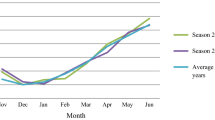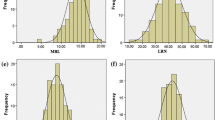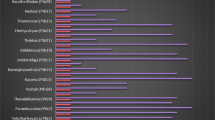Abstract
A sample of soybean accessions (Glycine max (L.) Merr.) from Huanghe-Huaihe-Haihe and Middle-Lower Changjiang Valleys in China was used to identify their tolerance to rhizo-spheric stresses, including drought, aluminum toxin and low phosphorus. A total of 15 accessions highly tolerant to at least one of the abiotic stresses were screened out. The correlation between drought tolerance and the relative values of total root length, root volume and dry root weight (relative to dry plant weight) were all significant at 0.01 level, respectively. So did for the correlation between aluminum toxin tolerance and the stress to non-stress ratios of the number of lateral roots, tap root length, total root length, root volume and dry root weight. The inheritance study on the above three root traits related to drought tolerance under segregation analysis indicated that between the two parents of the recombinant inbred line (RIL) population of (Kefeng 1 × Nannong 1138-2), the relative values of dry root weight, total root length and root volume were controlled by two major genes plus polygenes with their major gene heritability values 62.26%–91.81% and polygene heritability values 2.99%–24.75%, respectively, and for the latter two traits, the two major genes linked together with recombination value 4.30% and 1.93%, respectively. The inheritance study on the five root traits related to aluminum toxin tolerance revealed that between the two parents of the recombinant inbred line (RIL) population of (Bogao × NG94-156), the stress to non-stress ratios of lateral root number, tap root length, total root length and dry root weight were controlled by three major genes plus polygenes with their major gene heritability values 80.22%–91.81% and polygene heritability values 3.52%–11.39%, while the stress to non-stress ratio of root volume was controlled by three major genes with their major gene heritability value 93.44%. The (Kefeng 1 × Nannong 1138-2) RIL population was also used for mapping QTLs of relative dry root weight, total root length and root volume related to drought tolerance. Five, three and five QTLs located on Linkage group N6-C2, N8-D1b+W, N11-E and N18-K for each of the three traits, respectively, were identified. Each of the traits appeared to have one locus (Dw1, Rl1, Rv1) with relatively large effect in comparison with their other loci, and the three loci in above parentheses were located in the same region STAS8_3T-STAS8_6T on N6-C2 with a same distance to the flanking markers. Thus, Dw1, Rl1, and Rv1 even might be a same locus and performed as pleiotropic of a same gene. The results between segregation analysis and QTL mapping appeared relatively consistent, therefore could be used for verification each other.
Similar content being viewed by others
References
Carter T E Jr, Rufty T W (1993). Soybean plant introductions exhibiting drought and aluminum tolerance. In: Kuo C G, ed. Adaptation of Food Crops to Temperature and Water Stress. Shanhua: Asian Vegetable Research and Development Center, 335–346
Gai J (2006). Segregation analysis on genetic system of quantitative traits in plants. Front Biol China, 1: 85–92
Gai J, Wang J (1998). Identification and estimation of a QTL model and its effects. Theoretical and Applied Genetics, 97(7): 1162–1168
Gai J Y, Wang Y J, Wu X L, Chen S Y (2007). A comparative study on segregation analysis and QTL mapping of quantitative traits in plants—with a case in soybean. Front Agric China, 1(1): 1–7
Gai J Y, Zhang Y M, Wang J K (2000). A joint analysis of multiple generations for QTL models extended to mixed two major genes plus polygene. Acta Agronomica Sinica, 26(4): 385–391 (in Chinese)
Gai J Y, Zhang Y M, Wang J K (2003). Genetic System of Quantitative Traits in Plants. Beijing: Science Press
Garay A F, Wilhelm W W (1983). Root system characteristics of two soybean isolines undergoing water stress conditions. Agron J, 75(6): 973–977
Hoogenboom G M, Huck C M, Peterson R P (1987). Root growth rate of soybean as affected by drought stress. Agron J, 79: 607–614
Hudak C M, Patterson R P (1995). Vegetative growth analysis of a drought-resistant soybean plant introduction. Crop Sci, 35: 464–471
Hudak C M, Patterson R P (1996). Root distribution and soil moisture depletion pattern of a drought-resistant soybean plant introduction. Agronomy J, 88: 478–486
Liu F L, Andersen M N, Jensen C R (2004). Root signal controls pod growth in drought-stressed soybean during the critical, abortion-sensitive phase of pod development. Field Crops Research, 85: 159–166
Liu G Z, Gai J Y, Ma Y H (1989). Evaluation of drought tolerance of soybean germplasm from lower Yangtze and Huai Valleys. J Nanjing. Agric Univ, 12(1): 15–21 (in Chinese)
Sartain J B, Kamprath E J (1998). Aluminum tolerance of soybean cultivars based on root elongation in solution culture compared with growth in acid soil. Agron J, 70: 17–23
Sloane R J, Patterson R P, Carter T E (1990). Field drought tolerance of soybean plant introduction. Crop Science, 30: 118–123
Spehar C R (1994). Aluminum tolerance of soybean genotypes in short term experiments. Euphytica, 76: 73–80
Von Uexkull H R (1995). Global extent, development and economic impact of acid soil. Plant and soil, 171(1): 1–15
Wang J K, Gai J Y (1998). Identification of major gene and polygene mixed inheritance model of quantitative traits by using joint analysis of P1, F1, P2, F2 and F2:3. Acta Agronomica Sinica, 24(6): 651–659 (in Chinese)
Wang S, Basten C J, Zeng Z B (2001–2004). Windows QTL Cartographer 2.0. Department of Statistics, North Carolina State University, Raleigh, NC
Wang Y J, Dongfang Y, Wang X Q, Yang Y L, Yu D Y, Gai J Y, Wu X L, He C Y, Zhang J S, Chen S Y (2004). Mapping of five genes resistant to SMV strains in soybean. Acta Genetica Sinica, 31(1): 87–90 (in Chinese)
Wang Y J, Wu X L, Yu D Y, Zhang Y M, Chen S Y, Gai J Y (2004). Method of evaluation and adjustment of recombinant inbred line population and its application to the soybean RIL population NJRIKY. Acta Agronomica Sinica, 30(5): 413–418 (in Chinese)
Yan X, Zhang F S (1997). Plant Nutrition Genetics. Beijing: China Agriculture Press, 22, 40–41, 193–196 (in Chinese)
Zhang Y M, Gai J Y (2000a). Identification of mixed major-gene and polygene inheritance model of quantitative traits by using DH or RIL population. Acta Genetica Sinica. 27(7): 634–640 (in Chinese).
Zhang Y M, Gai J Y (2000b). The IECM algorithm for estimation of component distribution parameters in segregating analysis of quantitative traits. Acta Agronomica Sinica, 26(6): 699–706 (in Chinese)
Zhang, Y M, Gai J Y, Yang Y H (2003). The EIM algorithm in the joint analysis of quantitative traits. Genetical Research, 81: 157–163
Author information
Authors and Affiliations
Corresponding author
Additional information
Part of the results was published in Chinese in Acta Genetica Sinica, 2005, 32(8): 855–863 [部分译自: 遗传学报]
Note: Junyi Gai and Shouyi Chen are joint senior authors with equal responsibility.
About this article
Cite this article
Gai, J., Liu, Y., Lv, H. et al. Identification, inheritance and QTL mapping of root traits related to tolerance to rhizo-spheric stresses in soybean (G. max (L.) Merr.). Front. Agric. China 1, 119–128 (2007). https://doi.org/10.1007/s11703-007-0022-y
Received:
Accepted:
Issue Date:
DOI: https://doi.org/10.1007/s11703-007-0022-y




